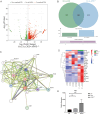Predictive value of ferritin heavy chains in the development of coronary artery calcification in patients on maintenance hemodialysis: a prospective cohort study
- PMID: 40810067
- PMCID: PMC12343228
- DOI: 10.3389/fendo.2025.1503940
Predictive value of ferritin heavy chains in the development of coronary artery calcification in patients on maintenance hemodialysis: a prospective cohort study
Abstract
Background: Vascular calcification (VC) is a well-established risk factor for cardiovascular disease (CVD) and mortality in patients on maintenance hemodialysis (MHD). These patients frequently present with hyperphosphatemia as well as disorders of iron metabolism. This study aims to explore the role of ferritin heavy chain (FTH) in the development and progression of coronary artery calcification (CAC) in patients on MHD and assess its predictive value.
Methods: Using a bioinformatics approach, we analyzed datasets related to VC. In our prospective study, we evaluated the Coronary Artery Calcification Score (CACS) alongside clinical markers, including serum FTH, serum ferritin, and transferrin saturation (TSAT), in patients on MHD at baseline and after a 1-year follow-up.
Results: Fth1 was identified as a differentially expressed gene significantly upregulated in the aorta of both ApoE-/- mice (atherosclerotic calcification model) and chronic kidney disease (CKD) mice (medial calcification model). Among patients on MHD, 85.71% exhibited CAC, with 49.09% showing progression. Patients with CAC tended to be older and have a higher body mass index (BMI). Notably, serum FTH and phosphorus (P) levels were significantly elevated in those with progressive CAC. Elevated serum FTH and high serum P were both independent risk factors for CAC progression and showed predictive value.
Conclusion: Elevated serum FTH and high serum phosphorus are clinically significant predictors of VC progression in patients on MHD.
Keywords: ferritin heavy chain; maintenance hemodialysis; predictive value; risk factors; vascular calcification.
Copyright © 2025 Chen, Tang, Pu, Xia, Li and Zou.
Conflict of interest statement
The authors declare that the research was conducted in the absence of any commercial or financial relationships that could be construed as a potential conflict of interest.
Figures



Similar articles
-
Progression of Coronary Artery Calcification and Risk of Clinical Events in CKD: The Chronic Renal Insufficiency Cohort Study.Am J Kidney Dis. 2025 Jan;85(1):67-77.e1. doi: 10.1053/j.ajkd.2024.06.018. Epub 2024 Aug 16. Am J Kidney Dis. 2025. PMID: 39154888
-
Association Between Ankle-Brachial Index and Coronary Artery Calcification Score in Patients Beginning Hemodialysis.Cureus. 2025 Jul 11;17(7):e87749. doi: 10.7759/cureus.87749. eCollection 2025 Jul. Cureus. 2025. PMID: 40786290 Free PMC article.
-
Phosphate binders for preventing and treating chronic kidney disease-mineral and bone disorder (CKD-MBD).Cochrane Database Syst Rev. 2018 Aug 22;8(8):CD006023. doi: 10.1002/14651858.CD006023.pub3. Cochrane Database Syst Rev. 2018. Update in: Cochrane Database Syst Rev. 2025 Jun 27;6:CD006023. doi: 10.1002/14651858.CD006023.pub4. PMID: 30132304 Free PMC article. Updated.
-
The effectiveness and cost-effectiveness of computed tomography screening for coronary artery disease: systematic review.Health Technol Assess. 2006 Oct;10(39):iii-iv, ix-x, 1-41. doi: 10.3310/hta10390. Health Technol Assess. 2006. PMID: 17018228
-
Phosphate binders for preventing and treating chronic kidney disease-mineral and bone disorder (CKD-MBD).Cochrane Database Syst Rev. 2025 Jun 27;6(6):CD006023. doi: 10.1002/14651858.CD006023.pub4. Cochrane Database Syst Rev. 2025. PMID: 40576086 Review.
References
-
- Chang TI, Streja E, Soohoo M, Kim TW, Rhee CM, Kovesdy CP, et al. Association of serum triglyceride to HDL cholesterol ratio with all-cause and cardiovascular mortality in incident hemodialysis patients. Clin J Am Soc Nephrology: CJASN. (2017) 12:591–602. doi: 10.2215/cjn.08730816, PMID: - DOI - PMC - PubMed
LinkOut - more resources
Full Text Sources
Miscellaneous

